#inner mongolian artists
Text
Mongolian Women Series by Artist Su Ruya.
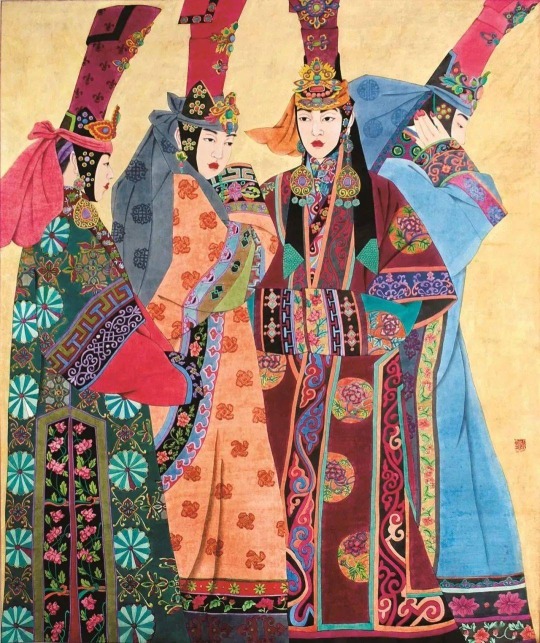
Mongolian Noble Women. Su Ruya. Painting, 2017 [image source].

Mongolian Woman No. 9, Mongolia Imagery Series. Su Ruya. Painting, 2002 [image source].

Mongolian Women No. 2, Mongolia Imagery Series. Su Ruya. Painting [image source].

Mongolian Women No. 1, Mongolia Imagery Series. Su Ruya. Painting, 1998. [image source].

Mongolian Woman No. 10, Mongolia Imagery Series. Su Ruya. Painting, 2002 [image source].
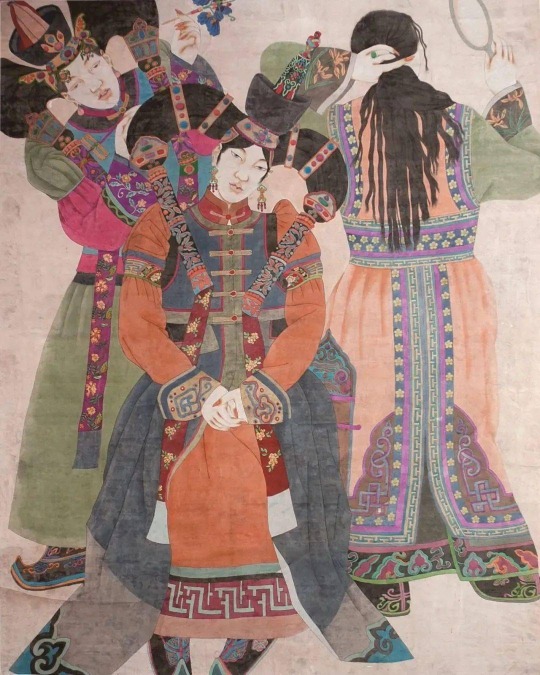
Golden Age. Su Ruya. Painting, 2014 [image source].

Mongolian Woman No. 15, Mongolia Imagery Series. Su Ruya. Painting, 2015 [image source].
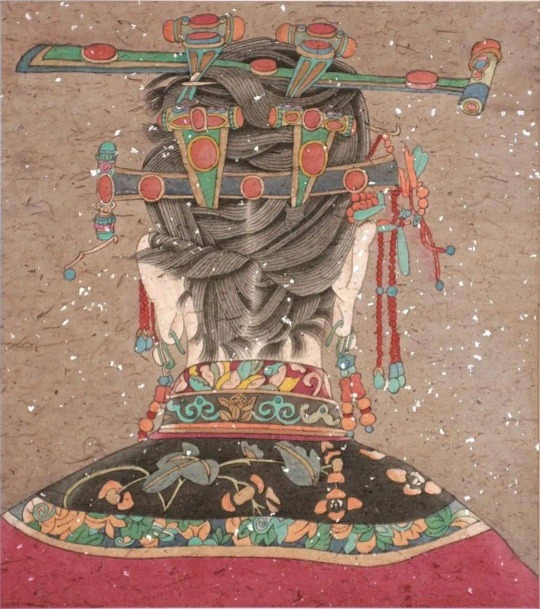
Mongolian Woman No. 5, Mongolia Imagery Series. Su Ruya. Painting, 2000 [image source].
#mongolia#inner mongolia#chinese art#china#chinese artists#inner mongolian artists#asian art#mongolian fashion#traditional mongolian fashion#su ruya#su ruya artist#painting#art#boqta#gugu hat
39 notes
·
View notes
Text
Our Manifesto
LET US TAKE YOU ON A DAY-DREAM
*It’s ok to be a space cadet here
Calliope’s interactive animated introductions teleport / crater / parachute / wrestle / plop / hip-check / zap / sucker-punch / tackle / dive-bomb / thwack / enchant / drop-kick / magic your imagination into short written stories. We edit each fantasy so that they don’t pull you out of the world for longer than you want to go—be that two minutes or twenty. Sometimes we revisit stories through multiple installments (punctuated novellas); other times we get in, tell a story, and get out of that universe in under two minutes (flash fictions); but most of the time we spend about ten to twenty minutes telling a single self-contained tale (short stories).
READ WHEREVER, WHENEVER, WHATEVER, FOR HOWEVER LONG YOU WANT
*In color
We love reading. But reading today is tricky because other visually striking apps on your phone are designed to steal your attention away from black and white (and utterly magical) text. Calliope levels that playing field by placing a vibrant and captivating animation in front of equally spell-binding writing on your phone. We want reading on your phone to be as effortless as scrolling through whatever other apps you enjoy.
WARNING: HUMAN WRITERS AND ARTISTS
*No robot art here
Humans created everything you see on our app, and always will. No matter what.
Robots aren’t humans and don’t experience an infinite inner world like we do. Calliope believes art (writing, water coloring, animating, ballerina-ing, Mongolian throat singing, basket weaving, whatever) is only about one human sharing their inner world with other humans. So while we’re looking forward to the day robots remove drudgery from work, we are unambiguously at war with swindlers passing off some robot’s pantomimed humanity as “art”.
CASH & PUTTING FOOD ON TABLES & OUR STUBBORN AD-HATE
*How we make money and what we use it for
Four dollars a month or thirty six bucks a year buys you all our stories. That money helps us feed our artists, make more stories, duct tape the app, and get people reading more. We also offer a free tier with fewer stories in case you’re not sure about Calliope yet.
We only make money through subscriptions, which in our opinion simplifies things a lot. Calliope creates and sells visual stories for a subscription. That’s it. You are not and never will be the product some advertiser pays us to ensnare. Even our free tier doesn’t violate your attention with advertisements.
3 notes
·
View notes
Link
Check out this listing I just added to my Poshmark closet: Zoe Couture Hand Dye Oversized Cardigan in Mongolia Cashmere, Medium.
0 notes
Text

Poster breakdown #3
I encountered this beautiful poster on Instagram when scrolling down. The poster was made by Inner Mongolian artist for a certain brand, in which Mongolian traditional typeface is displayed with a woman's face. It is clearly seen that grainy black background gives the layout more contrast. It is also seen that there is a bit of gradient in the image. The most creative part of this poster is that the fact that Mongolian vertical typeface is presented as a part of the woman's hair and gives the poster aesthetic and minimalistic overall look. Apparently, the poster isn't designed as with so many elements as other posters, but it still manages to deliver its subtle yet powerful meaning through all this simplicity.
PS: What the text says is "Anujin", a typical Mongolian female name
0 notes
Text
Reasons Why You Should Travel To Mongolian Deserts.
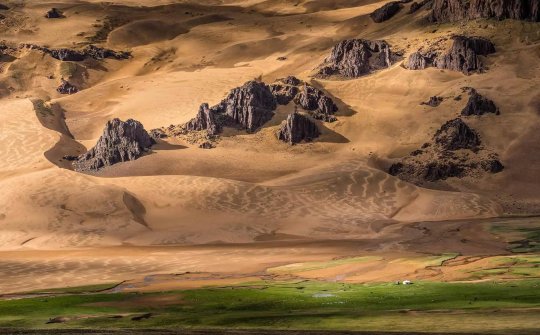
Mongolia is a country that is full of adventure and passion. It has a strong nomadic culture, making it an amazing place to visit to experience the beauty of nature and explore some of the most unique and diverse deserts in the world. Mongolian deserts are some of the world's most beautiful, captivating, and secluded places. From its majestic dunes to its stunning night skies, you should take a trip to Mongolia's desserts for plenty of reasons. Here are reasons why you should Travel Mongolia deserts:
Go Horse Riding & Camel Trekking
Nothing is quite as thrilling (or picturesque) as riding through a vast landscape on top of your favourite animal companion – whether on horseback or camel! In addition to providing an adventure separate from your more travel Mongolia experiences, horseback rail tours often lead riders down forgotten trails that reveal hidden attractions along the way.
Explore Ancient Rock drawings.
Mongolia’s Gobi desert is home to many ancient rock drawings and petroglyphs – fascinating stone carvings, shapes and figures that tell stories of bygone eras. Exploring these ancient sites provides evidence for Mongolia’s peculiar nomadic heritage, allowing visitors to glimpse their ancient culture.
Experience One-of-a-Kind Wildlife
The Gobi Desert is home to some of the world’s rarest wildlife species, like wild goats, gazelles and wolves. These animals have adapted to life in the hostile environment of the desert and can give visitors an unforgettable viewing experience. And if you’re lucky enough, you may even spot one of the bigger predators, such as snow leopards or bears! Home to rare breeds of gazelle, wolves and marmots, and animals like wild sheep, deer and camels – Mongolia offers unique wildlife spotting opportunities that cannot be seen elsewhere. Keep your eyes peeled – who knows what creatures may cross your path as you journey through these beautiful deserts?
Witness Amazing Sand Dunes
If one thing makes visiting a desert amazing, it must be witnessing a vast expanse of dune scenery! The Mongolian deserts provide a unique opportunity for this as they offer an uninterrupted view across miles of undulating terrain, with each plateau providing another awe-inspiring vista to behold. Driving across these massive landscapes is sure to leave any traveller breathless!
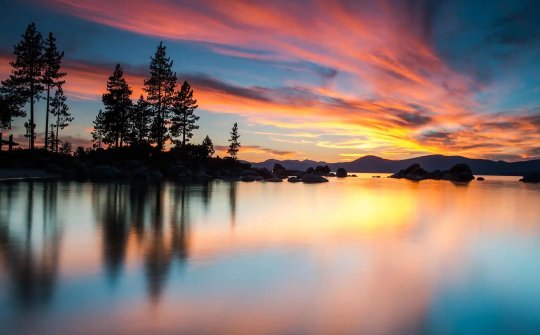
Enjoy Surreal Sunrises & Sunsets
Mongolia sunsets and sunrises are unlike anything else – they light up the sky with unbelievable hues that evoke peacefulness as no other place can match. Whether watching from atop a dune or from your camel caravan after a long day of trekking through the desert, it will be an experience hard to forget!
Unlock Your Inner Artist
In geography class, we learned about various landscapes; however, none offered such wonderful opportunities for expression as those found in Mongolian deserts. Amateur painters and photographers may find inspiration around every bend while walking or driving through these parts; unlocking your inner artist is reason enough for this journey!
Stargaze Under Unpolluted Skies
The night skies over Mongolia remain largely unpolluted due to a lack of human habitation which helps make them some of the best stargazing spots on our planet. As well known among stargazers: where there is no light pollution, many more stars can be seen (hundreds compared with just thousands). Be prepared for unparalleled views when looking out at night here!
Marvel at Panoramic Scenery
Mongolian deserts offer stunning vistas and gorgeous scenery unlike any other place. From vast dunes surrounded by towering mountains to rolling landscapes dotted with lakes and ponds, explore this amazing landscape while soaking up those breathtaking views!
Experience Authentic Mongolian Culture
The people of Mongolia are some of the most hospitable in the world, and visiting their homeland will give you a chance to learn about their culture first-hand. From traditional clothing and cuisine to singing and dancing, there are many ways to experience authentic Mongolian culture up close.
See Breathtaking Sunsets & Sunrise Views Often called 'the land between two oceans' since it stands between China's Yellow Sea and Russia's Pacific Sea, witnessing stunning sunsets on either coast can be breathtaking! From soaring mountains at night time against vivid oranges reflecting off vast waters, visiting Mongolian coasts leaves travellers mesmerized by its natural beauty in every way imaginable – all underneath traditional feels rooted deep within local cultures across each destination you explore here!
Takeaway
Explore Ancient Rock drawings.
Experience One-of-a-Kind Wildlife
Witness Amazing Sand Dunes
Enjoy Surreal Sunrises & Sunsets
Go Horse Riding & Camel Trekking
Unlock Your Inner Artist
Stargaze Under Unpolluted Skies
Marvel at Panoramic Scenery
Experience Authentic Mongolian Culture
0 notes
Text
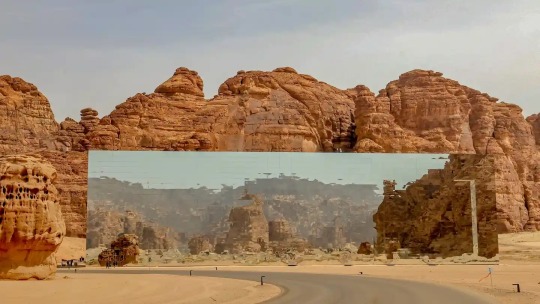
Mayara, Saudi Arabia 🇸🇦! The Maraya concert hall, the world’s largest mirrored building, is located in the ruins of the ancient oasis city of Al-’Ula, an Unesco world heritage site. An exhibition showing works of Andy Warhol is taking place at the venue until 16 May. Photograph: Fayez Nureldine/AFP/Getty Images

London, UK 🇬🇧! Adieu Interessant (Orange) by the Danish Artist Tal R goes on display at a preview for the ‘Ultra-Contemporary’ art sale at Phillips auction house next week. Photograph: Guy Bell/REX/Shutterstock

Mimicking a Moon: The simulation was designed to be as real as possible. NASA Astronauts Zena Cardman and Drew Feustel (above) wore mock spacesuits while navigating a field of lava rock in Arizona to test everything from chisels and face masks to documentation at Mission Control. These tests are being staged around the world and will help NASA put people on the moon as early as 2025.
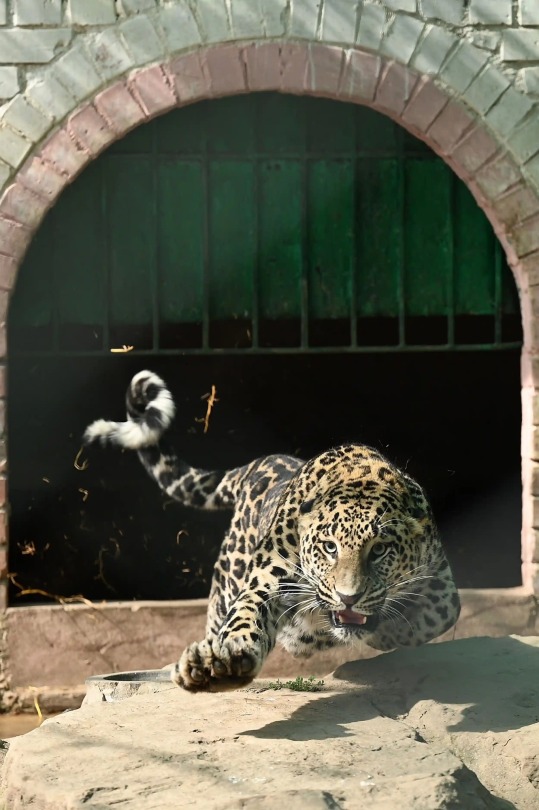
Islamabad, Pakistan 🇵🇰! A leopard, which was being kept as a pet, was captured from a residential area. The animal had escaped from a house and roamed the streets for hours before being captured and taken to a Zoo in the Capital. Photograph: Aamir Qureshi/AFP/Getty Images
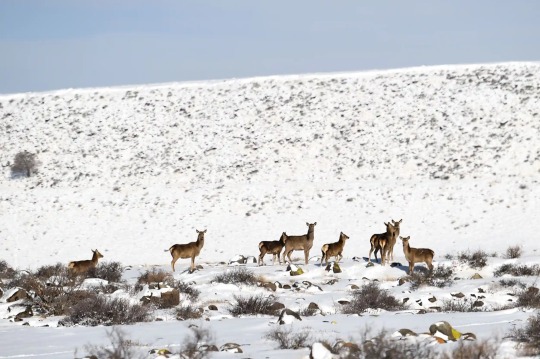
China 🇨🇳! Deer at the Helan Mountain national nature reserve in north China’s Inner Mongolia autonomous region. Photograph: Xinhua/REX/Shutterstock

Lianyungang, China 🇨🇳! Pied avocets fly over water at the coastal wetlands near the mouth of the Linhong River. Photograph: AFP/Getty Images
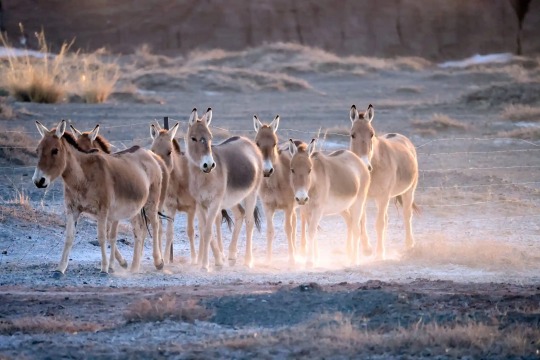
China 🇨🇳! A herd of Mongolian wild asses on the Urad natural reserve in China’s Northern Inner Mongolia autonomous region. Photograph: Xinhua/REX/Shutterstock

Snettisham, Norfolk, UK 🇬🇧! Oystercatcher and knot rest on a lagoon. Photograph: Dan Kitwood/Getty Images

Yangzhou, China 🇨🇳! Plum blossom blooms in the eastern province of Jiangsu. Photograph: Rex/Shutterstock
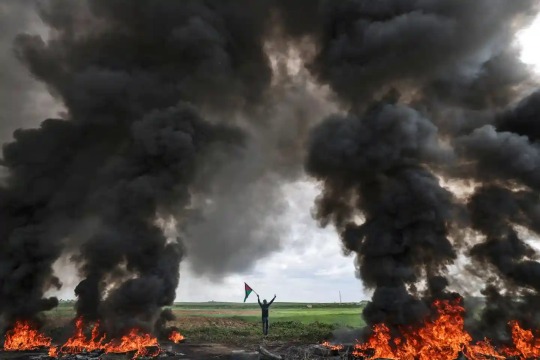
Gaza Strip, Forever Palestine 🇵🇸! Young Palestinians burn tyres during a protest near the Isra-hell-Gaza border east of the Jabalia refugee camp, a day after the deadliest Israeli army raid in the occupied West Bank in nearly 20 years. Photograph: AFP/Getty Images
0 notes
Text
New global copyright agent for independent music label
New global copyright agent for independent music label
Taiwan singer Amber Kuo (left) and Inner Mongolian musician Yider [SHINE]SHINE | 22-Oct-2022 | By Ma Yue
Universal Music Publishing Group (UMPG) hopes to introduce innovative Chinese music to the world by becoming the global copyright agent of independent Chinese music companies and their recording artists. The world’s leading global music publisher has signed more than 200 Chinese songwriters…
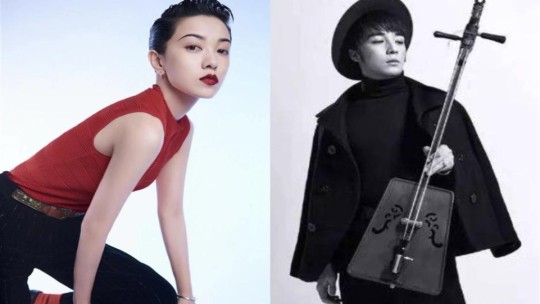
View On WordPress
0 notes
Text

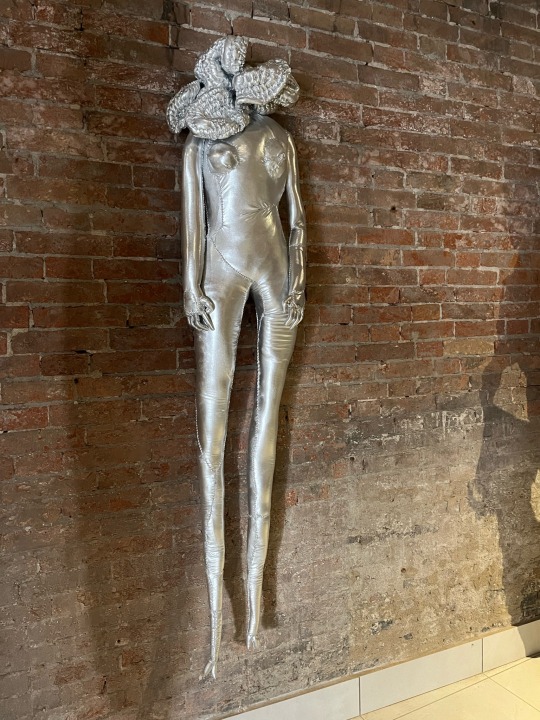

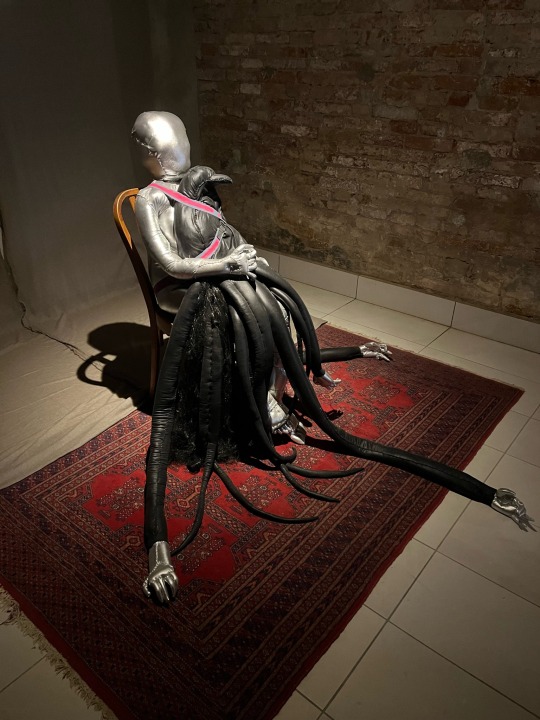

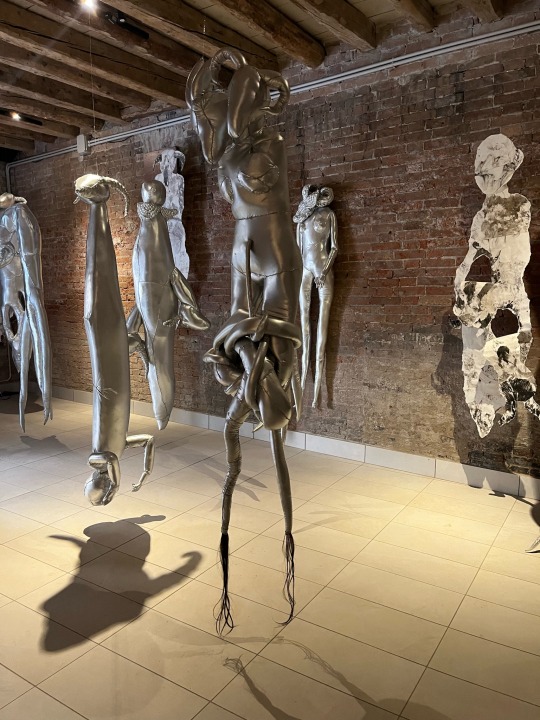
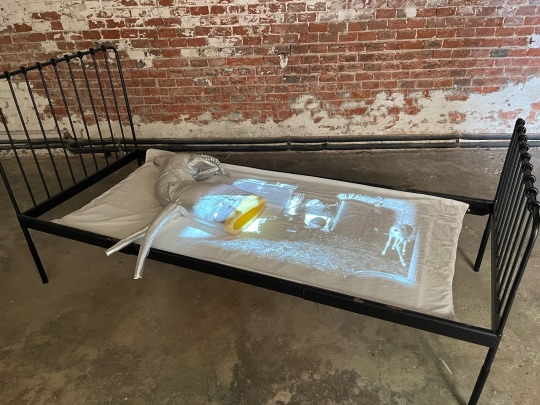
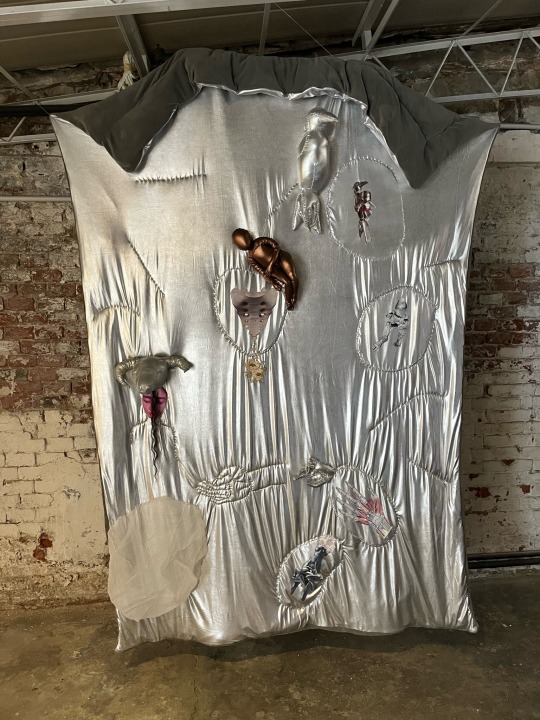

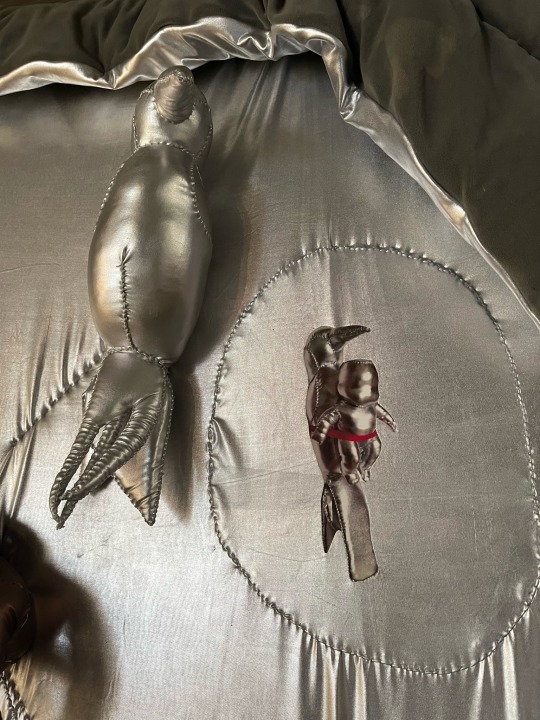
A Journey Through Vulnerability, Munhtsetseg Jalkhaajav (Mugi).
Mugi’s interdisciplinary works explore the notion of pain, fear, healing, and rebirth. Mainly reflecting her personal experiences, she investigates complexities of female bodies, minds and souls, and the connection with oneself and nature, while capturing tension between different realms. Seemingly fictional yet grounded, her unique works embody invisible forces such as spirits, and myths, and tell sensible stories of women, unborn children, and the sorrowful fates of animals. The exhibition presents sculptures, collages, and video pieces, spread across three different rooms entitled Miscarriage, Dream of Gazelle, and Pulse of Life, offering a journey through the intimate, fragile, yet powerful world of Mugi.
Inspired by Mongolian traditional healing methods and spiritual therapy, the process of her artistic creation is deeply intuitive and ritual-like. Through embodiments of the subject matter that evoke strong sentiments and juxtapositions of symbolic elements used for healing and protection, she meditatively examines the nature of her own anxiety and the process of its healing. Her particular ways of tearing, cutting, collating and stitching imply pain, anxiety, fear, hope and patience and create a specific language that allows Mugi to articulate and manifest her inner feelings and visions. In her works, birds represent the pulse of life, pregnancy, healing and protection, whereas female bodies represent her constant search for inner strength. The concept of reincarnation is the foremost interest of her artistic journey.
(Source)
#plavi in venezia#art#sculpture#venice biennale#the milk of dreams#biennale arte 2022#biennalearte2022#mongolia#Mugi#Munhtsetseg Jalkhaajav#collage#photo by me
1 note
·
View note
Text
Interview with Painter Xue Mo
New Post has been published on https://china-underground.com/2020/06/05/interview-with-painter-xue-mo/
Interview with Painter Xue Mo
She paints the magnificence of the inhabitants of Inner Mongolia.
Xue Mo is a contemporary painter born in Inner Mongolia. She studied at Ximon Normal School, Art Department, and got her Bachelor on Fine Arts, from Meitan Normal College. Xue Mo is internationally acclaimed for her subjects that represent female beauty. Her portraits are described as “Chinese Renaissance”, or “Medici alike portraiture”. Her artworks and early portraiture deeply affected by culture, tradition, and the structure of nature, exploring the human figure in a relationship with history and land. Her artworks were featured in several exhibitions at key galleries and museums all around the world, just to mention Australia, Singapore, the United States, Hong Kong, etc … She lives and works in Beijing, China.
Official site | Facebook | Instagram
Xue Mo
How and when did you get into painting? How did you discover your painting vocation?
On a break between my college graduation, and before starting training as a teacher, I took a holiday back in my hometown in Inner Mongolia and painted a few of my portrait pieces. I found great enjoyment in being a self-employed artist. This was in 1996, the year I started my artistic career.
Who influenced you as a person and as an artist?
My father, a Chinese doctor, is a huge inspiration to me. His many boxes with different plants and herbs have always fascinated me. He is also a real nature lover.
Xue Mo’s artwork highlights the inherent beauty of the women from her homeland
Mongolian Girl Series No.21, oil on linen, 69.5 x 59.5 cm, 2012, Karin Weber Gallery
Is there an art movement from the past or an artist that you love in particular?
Italian Renaissance. I love their enthusiasm for detail while staying close to basic structures.
Where did you study and develop your skills?
I was lucky to have a private art teacher. My father invited a local painter to teach me and my twin sister when we were 10 years old. The teacher later established and ran a local art school.
Xue focuses on women’s beauty. Her subjects’ identity evokes a spiritual serene atmosphere, inner meditation, and balanced tranquility
Mongolian Girl Series No.23., oil on linen, 72.5 x 61.5 cm, 2013, Karin Weber Gallery
What does painting mean to you? What do you love most about it?
Painting is my life. It is the only way for me to offer my best to other people.
How long does it take to make one of your paintings?
Normally a good work takes two to four weeks, but time is not the most important factor. You need to be in a good state of mind, which may take a few months, even a few years to reach. Good art is much more expensive than its price tag.
Xue Mo’s paintings evoke a timeless elegance and her subjects are impressing for their noble simplicity
Mongolian Girl Series No.33, oil on linen, 50 x 40 cm, 2018, Karin Weber Gallery
The subjects of your portraits carry a balance between natural beauty and magnificence, simplicity and regality. Is this one of the messages you would like to be perceived?
My portrait work is actually about myself. Portraits capture my feeling about the beauty of my subject, no matter who the model is. This is about the beauty that is seen by me and felt by me.
Are there any of your portraits related to a significant moment in your life or dedicated to someone which you feel particularly connected toCan you share with us the story?
Mongolian people, especially Mongolian girls have a special inner, powerful beauty for me. Maybe because I was born there, and experienced harsh conditions growing up, I can relate to them.
When I visit countries abroad and in particular, their museums and galleries, and, from reading many art books, I am continually drawn to the works of the early Renaissance; masters such as Piero della Francesca, Paolo Uccello, Hieronymus Bosch, Bruegel the Elder and Pisanello. I am deeply moved by these artists’ intentions and creative spirit, as much as my admiration for the Mongolian and the grasslands.” – Xue Mo
Mongolian Girl, oil on linen, 75.5 x 66cm, 2012, Karin Weber Gallery
What does it mean to be a paintress today in the age of social networks?
My art has no direct connection with social networks or a social situation. It only connects with the human body and life itself. This is the only source of my art. Life +Sex +Body +Beauty=Art.
She paints the magnificence of the inhabitants of Inner Mongolia, with simple but precious clothes, living in a beautiful grassland in harmony and serenity with nature.
Mongolian Girl Series No.44 Xue Mo oil on linen 70 x 56cm 2018, Karin Weber Gallery
Xue Mo’s artwork highlights the inherent beauty of the women from her homeland.
Photos courtesy of Xue Mo and Karin Weber Gallery
A Special thanks to Stephanie Braun
#ChinesePainter, #InnerMongolia, #Mongolia
0 notes
Note
Hello dear writer/artist/wonderful human being,
Tumblr just showed me one of your posts and I realised that I never told you how amazed I am by your prose both in the game and on your blog (I feel simply calling it writing doesn‘t cut it). How you put your thoughts, emotions and atmosphere into descriptions and dialogue is absolutely stunning to me and feels ‘artsy‘ to me in the best possible way. I love this particular very inner-workings/stream of consciousness (?) based storytelling (I‘m not a literature expert, it‘s just how I would describe it). It made me fall absolutely in love with your characters while also being in awe/slightly intimidated of/by them - which I think works very well with the atmosphere you‘re creating, especially in scenes with Charet (which is again supported by the music and your amazing art).
I can‘t wait to play more of it someday (and until then I‘m just gonna replay it over and over again) and hope you feel appreciated by this <3
Have a lovely day ~

...
Thank you so much.
Your messages left me speechless - and it is very difficult for me to describe, with all the possible colors of the language, how much they inspired and brought me into a state of delight for a long time, helping to work on new, more complex projects long before I had the courage to write this response text.
And I yearned and suffered from the fact that I could not think of something worthy that could show at least a part of my gratitude and admiration for your softness and feelings, and I would like my answer to seem complicated and interesting this time, since I would never want to leave you empty-handed. Yesterday morning, a very strange, special and inherently distant insight came to me - and I hasten to share with you everything that came to my mind, and I hope that you will like it more uwu
The difficulty was also that I am not so much fond of fiction in the traditional concept - my pace of life is restless and changeable, and, as a rule, I have enough patience and perseverance only for poetry and short stories, guided to a greater extent by a sense of aesthetics and associations (because yes, my writing style is a stream of consciousness and you completely hit the mark - I can't write in any other way, except relying on feelings and impressions * --- *) than a serious approach to the plot and idea. Apart from literature (and any other sources), which would be too hackneyed and understandable in its fame, it seemed to me that there were very few things that could interest and impress you, but now I want to think that I was wrong.
The list that I have sketched consists of writers and poets, who are united by the main thing - the fact that they are equally representatives of the same culture with me, and their feelings and aesthetics, colorfulness and sense of language were with me from the beginning of my early years and formed my idea of the world and about the art of writing in general. In other matters, I do not think that the writing style and elements of history and culture will be simple and understandable - I myself have not always felt attraction and warm feelings towards them, but this is something that, I hope, can turn out to be completely new and fresh, not like anything you have experienced before experience, yet close in spirit to what I am myself trying to portray.
Starts from lighter comedies and flamboyant plays and ends in dark fantasy and heavy historical drama. The first of them are very short and read in one gulp - the last are longer, but with a reasonable volume of novels, so they can keep you busy, yet not bored;)
1. "Forest Song" by Lesia Ukrainka. This is a play written in a bright and lively language - but this is a great start if you want to read something light and airy, yet with elements of dark fantasy and Slavic folklore. The combination a little strange at first glance, - this a romantic fairy-tale play that tells about Mavka (a forest nymph), who was in love with a young human man. "Forest Song" is easy to perceive as a poetic fairy tale, but it also has a dark and tragic ending, and raises the theme of human existence in nature and the world in itself - their struggle between feelings, inspiration, brightness of perception and down-to-earthness of life, simple and understandable needs . This play prompted me to think about Margot - as the personification of these worlds and worries, but much darker, heavier and more mysterious, far from human nature.
2. "The Night Before Christmas" by Nikolai Gogol - a writer who has always been the most important and favorite for me, with a rich and varied language which I tried to copy and imitate most of my school years. "Night before Christmas" is included in the collection "Evenings on a Farm near Dikanka", which are equally small masterpieces, but it was "Night" that was a vivid and memorable experience, with such a close aesthetics of a small settlement, a heavy blizzard, creaking snow, and devils, prowling in such a mysterious darkness. This is a comedy with idealized romance - and based on it, both films were made and plays are staged, and it tells about the hopelessly in love with beautiful Oksana blacksmith Vakula, who with a cunning mind captured the devil and forced him to help Vakula in courtship. The story is very down-to-earth and light, but with elements of everyday life and culture of the Ukrainian hinterland, which can either turn out to be an interesting experience or push you away to your liking. There are Christian rituals, and descriptions of everyday life, and witches, and folk beliefs, elements of mundane comedy, the historicity of that era and many bright and partly gloomy aesthetics. This part of the culture is closely related to my thoughts and ideas about Margot, as well as about other characters and travelers from the continent (I was also inspired by the Romanian, Georgian, Mongolian and Tatar cultures equally *---*)
3. "Taras Bulba" by the same Gogol is a historical tragedy, difficult and complex, but with strong artistic elements - with a powerful feeling of a gloomy, dark era, characters in which many real and legendary persons were combined, and although they speak of it as romantic nationalism, I have never perceived it in this way (and I do not advise anyone, given the fact that you can find similar elements in almost every name in this literature). It tells about the Zaporozhye Cossack and his two sons, about the times of long wars and dark ages, and it will be a bright and exciting experience for someone far from this culture - it vividly and richly displays the life and psychology of a country that has long ceased to exist.
4. "Shadows of Forgotten Ancestors" by Mikhailo Kotsyubinsky is a dark historical story, written under the strong impression of the gloomy and mysterious culture of the Hutsuls - the Ukrainian culture of highlanders and old pagans, and the story, at first similar to a much heavier and darker version of Romeo and Juliet, smoothly flows into dark fantasy. It contains the complex psychological baggage of the hero, and a colorful description of such a strange and distant culture, the history of blood feuds and marital betrayal, and the dark forces of a crushing and dangerous nature dominating the earth.
Oh, and also, perhaps, if you have an interest in poetry - I have two big names, Ivan Franko and Taras Shevchenko. The first is a bright romantic of Galicia, with deep sensuality and passion, the second is the father of Ukrainian literature, a poet and artist, the son of a difficult and dark era with art to match him.
...
So..
Thank you so much again.
I adore you with all my heart, and of course you can take as many hugs as you want;зз
30 notes
·
View notes
Text
LITERATURE
SOUTHEAST ASIA
Southeast Asia or Southeastern Asia is the southeastern subregion of Asia, Southeast Asia is composed of eleven countries of impressive diversity in religion, culture and history: Brunei, Burma (Myanmar), Cambodia, Timor-Leste, Indonesia, Laos, Malaysia, the Philippines, Singapore, Thailand and Vietnam.
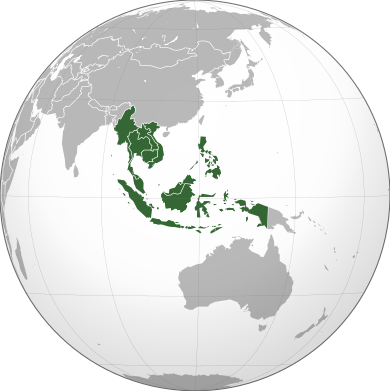
The earliest Homo sapiens presence in Mainland Southeast Asia can be traced back to fifty thousand years ago and to at least fourty thousand years ago in Maritime Southeast Asia. As early as ten thousand years ago, Hoabinhian settlers had developed a tradition and culture of distinct artefact and tool production. During the Neolithic period, Austroasiatic peoples populated Indochina via land routes and sea-borne Austronesian immigrants preferably settled in Maritime Southeast Asia. The earliest agricultural societies that cultivated millet and wet-rice emerged around 1700 BCE in the lowlands and river floodplains of Indochina
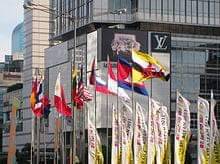
"ASEAN members' flags in Jakarta. Modern Southeast Asia has been characterised by high economic growth by most countries and closer regional integration. Indonesia, Malaysia, the Philippines, Singapore and Thailand have traditionally experienced high growth and are commonly recognised as the more developed countries of the region. As of late, Vietnam too had been experiencing an economic boom. However, Myanmar, Cambodia, Laos and the newly independent East Timor are still lagging economically."
According to my research, it says that "On 8 August 1967, the Association of Southeast Asian Nations (ASEAN) was founded by Thailand, Indonesia, Malaysia, Singapore and the Philippines. Since Cambodian admission into the union in 1999, East Timor is the only Southeast Asian country that is not part of ASEAN, although plans are under way for eventual membership. The association aims to enhance co-operation among Southeast Asian community. ASEAN Free Trade Area has been established to encourage greater trade among ASEAN members. ASEAN has also been a front runner in greater integration of Asia-Pacific region through East Asia Summits." This is according to wikipedia.
The notable literary genres in southeast asia are;
Traditional Oral Literature- Folktales, Proverbs, Riddles, legends.
Religious Narratives and Literature- Buddhist Codes and verses, Jataka Tales.
Narrative Poetry - Epic Stories.
One of the example is The legend of Princess Kinnaree Manorah by Anthony Phanvilay is an example of south east asian myths. This story of Manorah has inspired a dance form known as the Manorah Buchayan.
EAST ASIA
East Asia is the eastern region of Asia, which is defined in both geographical and ethno-cultural terms
East Asia is politically divided into eight countries and regions: China, Mongolia, North Korea, South Korea, Japan, Hong Kong, Taiwan, and Macau.
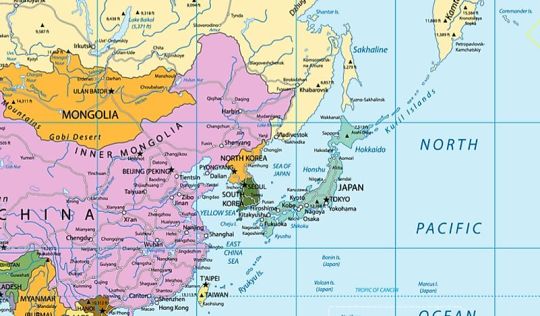
East Asia, one of the five regions of Asia, is located east of Central Asia, with its eastern border running along the East China Sea. East Asia is politically divided into eight countries and regions: China, Mongolia, North Korea, South Korea, Japan, Hong Kong, Taiwan, and Macau. This region covers a total area of 4,571,092 square miles and has a population size of more than 1.641 billion, which represents 22% of the global population and 38% of Asia's total population. Many residents of East Asia are concentrated in major metropolitan areas such as Beijing and Tokyo.
The geography of East Asia is varied depending on the zone. The inner continental area experiences a temperate climate, while Mongolia is covered by the arid Gobi desert. China, the largest country in the region, is home to both mountains and plateaus, while Japan is characterized by thousands of islands and coastlines. Today, East Asia is believed to have some of the most advanced technologies in the world, which fosters economic development.
East Asian literature includes:
Chinese literature
Japanese literature
Korean literature
Mongolian literature
Taiwanese literature
EXAMPLE OF THEIR ART
Chinese art is visual art that, whether ancient or modern, originated in or is practiced in China or by Chinese artists. The Chinese art in the Republic of China (Taiwan) and that of overseas Chinese can also be considered part of Chinese art where it is based in or draws on Chinese heritage and Chinese culture. Early "stone age art" dates back to 10,000 BC, mostly consisting of simple pottery and sculptures. After this early period Chinese art, like Chinese history, is typically classified by the succession of ruling dynasties of Chinese emperors, most of which lasted several hundred years.
SOUTH AND WEST ASIA
South and West Asia is also identified by its economic potential and growth. The region is valued for its supply of low cost goods, services and skilled labour to the global economy but at the same time, it is notorious for the payment of low wages, appalling working conditions and trafficking of labour. This changing economic landscape has had a corresponding impact on the social and geographic fabric of the region.
South Asia has a peninsula-like shape that is bordered by three bodies of water: the Indian Ocean to the south, the Bay of Bengal to the east, and the Arabian Sea to the west. The region includes Indian subcontinent and surrounding countries. South Asia is politically divided into eight autonomous countries: Sri Lanka, Bangladesh, India, Afghanistan, Pakistan, Bhutan, Nepal, and the Maldives. The region covers a total area of roughly two million square miles and has a population size of more than 1.74 billion, which is nearly a quarter of the global population. Additionally, South Asia has the distinction of being the most densely populated area in the world.

West Asia is located in the area between Central Asia and Africa, south of Eastern Europe. The majority of the region is often referred to as the Middle East, although it geographically excludes the mainland of Egypt (which is culturally considered a Middle Eastern country). West Asia is politically divided into 19 states: Georgia, Armenia, Azerbaijan, Turkey, Cyprus, Syria, Lebanon, Israel, Palestine, Jordan, Iraq, Iran, Kuwait, Bahrain, Qatar, Saudi Arabia, United Arab Emirates, Oman, and Yemen. It also includes the Sinai Peninsula of Egypt. The region covers a total area of around 2.415 million square miles and has a population size of 313.428 million.
A large area of the region is covered by an arid desert environment. However, West Asia does have several points of access to large bodies of water, including the Black Sea, Persian Gulf, Arabian Sea, Red Sea, Caspian Sea, Mediterranean Sea, and the Aegean Sea.

Anglo-Americans
are people who are English-speaking inhabitants of Anglo-America. It typically refers to the nations and ethnic groups in the Americas that speak English as a native language who comprise the majority of people who speak English as a first language.

Languages
English (American, Canadian, Jamaican, Trinidadian, Guyanese, Belizean, Bajan, Bahamian, Vincentian, Grenadian, Anguillian, Montserrat, Antiguan and Barbudan, Saint Kittian and Nevisian, and Falkland Islands)

Europe
second smallest of the world’s continents, composed of the westward-projecting peninsulas of Eurasia (the great landmass that it shares with Asia) and occupying nearly one-fifteenth of the world’s total land area.
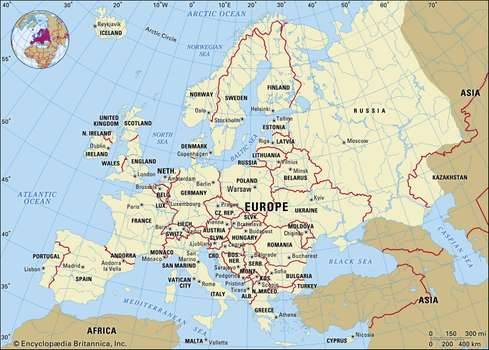
AFRICA
Africa is the world's hottest continent with deserts and drylands covering 60% of land surface area (e.g. Kalahari, Sahara and Namib). Africa is the world's second driest continent (after Australia). Africa has approximately 30% of the earth's remaining mineral resources. Africa is also the world's second-largest and second-most populous continent, after Asia in both cases.
All in all, there are 54 sovereign African countries and two disputed areas, namely Somaliland and Western Sahara (see the list of African countries below).

African literature
the body of traditional oral and written literatures in Afro-Asiatic and African languages together with works written by Africans in European languages. Traditional written literature, which is limited to a smaller geographic area than is oral literature, is most characteristic of those sub-Saharan cultures that have participated in the cultures of the Mediterranean. In particular, there are written literatures in both Hausa and Arabic, created by the scholars of what is now northern Nigeria, and the Somali people have produced a traditional written literature.
LATIN AMERICA
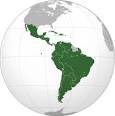
Latin America is a group of countries and dependencies in the Western Hemisphere where Romance languages such as Spanish, Portuguese, and French are predominantly spoken.
The region consists of people who speak Spanish, Portuguese and French. These languages (together with Italian and Romanian) developed from Latin during the days of the Roman Empire and the Europeans who speak them are sometimes called 'Latin' people. Hence the term Latin America.
LATIN AMERICA LITERATURE
Latin American literature refers to written and oral works created by authors in parts of North America, South America, and the Caribbean. Latin American authors usually write in Spanish, Portuguese, English, or a language native to their specific country.
Credits to google and wikipedia for the images and some infos!
by; ELLAINE HIPOLITO
6 notes
·
View notes
Text
RPG Campaign Setting Thoughts - The Planes
Sometimes you just get kinda burnt out writing stuff for other people’s settings and have to write stuff about your own. Expect a series of these, maybe, my track record for long-form stuff on this blog sucks. Today though, here’s some notes on just the fundamental underpinnings of the setting. Let me know what you think here, because eventually if I get enough of this I might like, kickstart a book on it (with, you know, good art) and/or write adventure paths or something.
The world as we know it, the sun, all the stars in the sky, and everything between them comprise what some refer to as the Prime Material Plane, Creation, or The Great Canvas, onto which Brin [bad placeholder name there] paints our world and some speculate many others, creating the land, the sky, and all that ever lived.
Much like a mortal painter, Brin holds a Great Palette [ethereal plane?], which holds the raw stuff of creation - the elements. Fire, earth, air and water, in their purest forms. [Probably also Positive/Negative energy, para/quasi-elemental planes too] Were one to travel to the Great Palette through magic, they would not experience these as blobs of pigment on a board, but each as their own reality, as infinitely vast as the Great Palette, but lacking its variety, each comprised in its way only of a single element, and magical beings born thereof. As these elemental planes are closer to Brin, they are sometimes known as the Inner Planes.

Beyond the Great Canvas, and indeed, beyond the reach of Brin entirely are the Outer Planes, or the Great Beyond. Home to the other deities, and the destination of souls after death. [And that’s all I’m really inclined to say here because I don’t particularly have any tweaks for the outer planes beyond avoiding the copyrighted bits, but if I do a book, yeah.]
While the Great Canvas is a singular whole, always representing the entirety of our physical reality as it presently stands, Brin’s work is never-ending, their hand always at work, repainting some corner of the canvas, touching up details, or painting over vast swaths in a sudden fit of inspiration. Our own world is a small enough part of the whole that such drastic revisions are rare, and thought by many to be a portion of the canvas Brin particularly favors, but over millennia, our world has been vastly revised several times, and in more recent years, the strokes of Brin’s brush have made alterations to several individual regions. [So there’s weird unexplored places near major population centers!]
When Brin’s brush repaints the world in this manner, what once existed is never truly lost. Much as one with a careful hand can chip away the paint on a heavily revised canvas to reveal an earlier state, so too is the Prime Material plane comprised in truth of many layers, and in rare places, cracks of sorts allow safe passage beyond our present layer and one that lies beneath. Portals, in a sense, to cities, countries, perhaps even entire worlds Brin felt the need to replace, some still home to creatures and civilizations at odds with the world as we now know it. [This is the Big Blank Check of the setting. With care, ‘cracks in the paint’ like this allow for mind-blowingly huge underworlds, Underdark/Hollow World style, weird distorted early sketches for the world like Pathfinder’s First World and Shadow Plane, or a nice compromise if there’s some particular aspect of a different campaign setting you just can’t bring yourself to leave out of a new campaign and want to grandfather in without messing with the rest of the world. And yes, this whole conceit comes with the very meta implication that every Main Campaign World for a major fantasy RPG are layered on top of each other like this.]
[A couple notes on races here too, because they’re tied in to the above and I don’t know if I’m up for dedicating a whole update just to them. My first instinct was to just not have races. I’ve never really been a fan. They encourage power gaming for stats, a whole lot of actual racism, flat simplistic mono-cultures, screwy language rules, and it never makes sense that everyone’s living in the same cities in the same population ratios. BUT I’m really striving for backwards compatibility, so...
Halflings and Giants exist because Brin isn’t always especially consistent with scale and perspective. There’s just parts of the world where people were created really big or really small next to common frames of reference, like in medieval paintings where a person is somehow the same height as an entire tree and also a dog or whatever.
Half-Elves and Half-Orcs are their own distinct races. A human and an elf can’t have a kid together, nor a human and an orc. They came about because Brin was revising the world, and some people were in living along the edges of where new races, which ended up as somewhat blend areas so the new additions wouldn’t cause too much contrast. This is also why they’re fairly rare.
No particular plans for doing anything weird with dwarves and gnomes yet. Dwarves might have dug their way up from an older layer? I like Pathfinder’s take on gnomes as First World immigrants but that’s probably infringe-y. Maybe bring pointy hats back?
Also? Orcs are white people. Like, not literally, still going to be green (with maybe lighter, near white shades in the mix too). Culturally. Bunch of monotheistic, patriarchal, self-aggrandizing, colonizing brutal scumbags, prone to wearing powdered wigs and impractical clothes with ruffles and buckles everywhere, as a major villain for the setting as a whole. Too many works of fiction, which is to say all of them, have depicted orcs as “primitive evil savages” and then just blatantly depicted them as Mongolians/black people/Native Americans/whatever group they have unfortunate subconscious issues with, so, screw all that, time to do them as the actual evil marauding empires trying to conquer and enslave the whole world for a change. Deal with it.]
BRIN - TN Deity
Home- Beyond the Planes (with command over the Inner Planes and Prime Material)
Domains - Air, Earth, Fire, Water, Weather
Common Worshipers: Artists, Crafters, Explorers, the Dissatisfied
Goals: Perfecting the world, in an artistic sense.
Direct Interventions: Brin is capable of sweeping drastic changes to the Prime Material Plane or any of the Inner Planes, but is completely unconcerned with most mortal and even divine concerns. They are only likely to intervene directly in events causing drastic changes to the Prime Material Plane outside of their vision for it, and tend to do so with sweeping changes to the fabric of reality.
Blind Spots: Brin never intervenes with, nor even observes anything in the outer planes, and will not grant spells to worshipers who travel there.
[Brin is kind of a terrible pick for a deity to worship, honestly. Bit on the alien side, and if you really get their attention, it’ll be more likely that your home town is now a beach than anything helpful to your situation.]
5 notes
·
View notes
Link
Check out this listing I just added to my Poshmark closet: Zoe Couture Hand Dye Oversized Cardigan in Mongolia Cashmere, Medium.
0 notes
Link
Writers? This is the artistic version of a short story.
Artists...?
...WHY??
So...many...questions.
A lot of this breaks what writers call “the willing suspension of disbelief.” It’s where the audience is willing to overlook implausible things in order to keep following the story. At some point their credibility has a limit, a breaking point where their ability to suspend and ignore their disbelief will snap, like hanging a thread from the ceiling, and then putting too much weight on it.
Some of these weighty questions include:
Why is she "standing" like that? She looks like she's sitting on an invisible stool!
Why is her cloak/sheet still bound up like that if she's been fighting long enough to get her sword bloodied?
Why is she so pristine when the wyrm corpse is clearly freshly arterially injured??
Why does she have no shoes and pristine feet when she’s clearly touching a bloody corpse?
Why is the tag end of her cloak/sheet...thing...whipped up under one leg and over the other when she’s been chopping up a monster and now has to fight another one?
Again, why is she so clean??
There are so many WTF questions...
What is she sitting on?
If she’s not sitting on anything, how is she supporting her weight in that position?
She’s not being supported by her feet, that’s for sure--is she seriously en pointe with her left foot (the one on our right, visually)?
And the one on the left (her right foot), if it’s resting at a 45-ish degree angle on a corpse so freshly butchered it’s still spurting, how is it she’s able to keep it in place when it should be slipping out from under her by all the laws of squshy meaty blood-filled things?
Where is the missing V shaped wedge of that tail? Look at the angles on those two cut ends; there is clearly a whole big fat wedge of flesh that is missing! If there wasn’t, that tail would literally have been an L shaped structure with the cut angling on the diagonal down into the corner, and that is just disturbing to contemplate...
...Where are the arm bones in those dragon-wings?? Seriously, that is disturbing, seeing the thin metacarpals and phalanges (the “finger bones” of wings if you look at wings as nothing more than elongated & weirdly angled hands) ...but not the arm bones...so where are they??
...Now this isn’t to say the picture is all bad! The concept is actually a neat idea, looking like a cross of Lord of the Rings meets all those hedonistic Renaissance paintings of the Ancient Greek mythos. And it would be 100% correct to mix mythos like this, as the Renaissance painters were doing that all over the place, mixing Greek mythos symbology into Biblical art, and vice versa (all of which was fan art, btw).
The streaky effect of the Nazgûl is wonderful, though I’d like to see a bit more tattering (along the same diagonal upper left to lower right lines) on that right side of the Ringwraith fellow, there.
The Ringrwraith even seems to be bending the airwaves around and above him, with the effects of the clouds sort of streaking in toward that bright spot in the sky above and behind. It makes it look like the halo is sucking in all the Light before fleeing into the West, or trying to suck the Nazgûl off the face of the planet to hopefully disinterate its evilness out of existence...
The bright part of the sky also kind of looks like dragonbreath fire, even though the Fell Beasts that the Nazgûl rode upon aren’t evern mentioned (as far as I can recall) as being able to breathe fire like dragons. So that’s another point of coolness.
I have no idea what’s going on anatomy-wise of the presumed fallen and chopped up Fell Beast, but at least some effort has been made to provide it with a (weird) internal structure. If it really is a Fell Beast and not meant to be a dragon or a wyrm, then I can accept the odd anatomy and darkness of the...I’m not sure if those are bones, but I’m presuming that it has some bones in its tail, and if it’s a foul abomination style creation, I can accept the creator had no clue.
I do like the crispness of the woman in focus versus the Nazgûl who is equally clearly not in focus.
Certainly the woman definitely looks like a Renaissance painting of a Greek Mythos Action Sequence! She’s in a classic serene, poised action pose that no doubt has some sort of supporting stool & armature behind and under the original model for her to rest her arms upon.
The symbology of Shield Maiden of Rohan certainly gets the first two components of that descriptor down visually: for the first part, she has a shield (lovely round thing, very Classic Greek Hero With Spiffy Expensive Metal Shield), and she definitely is using it to shield herself from something. (Plus the sword.) The other part of the symbology is the “modesty sheet drape” under one thigh (gotta show off them nekkid thighs, Renaissance foiks!!) and up over the other, between the legs, blocking off any view of or access to the mons pubis...aka, shielding her maidenly modesty.
However, there is zero sign she’s from Rohan, because there’s zero symbolism representing Rohirrim culture...and the key element to Renaissance pictures of various cultures’ mythos were that they were rich with symbolism. The Rohirrim, the Riders of Rohan, were emphasized over and over as horse people.
Tolkienn also cribbed the Scandinavian culture for his descriptions of them (I suspect the Golden Hordes of the Russian Steppes, heavily influenced by the Rus folks who were Scandinavians who had moved east and mingled with the Mongolian Empire remnants who a little earlier had moved west. The Greeks knew of the Scandinavian peoples (no, really, they knew of them! Electricity is actually just the Latin word elektron (which comes from a similar-sounding Greek word I’m not going to bother to spell correctly), which meant amber, as in the petrified pine pitch being shipped down through Europe from the Baltic Sea in the far north, which is surrounded by Scandinavian countries.
Yet there’s no signs or symbols of Scandinavia about her, no knotwork animals, no amber, just pale blonde hair (which frankly could be representative of the British Isles or partial albinoism)... So while there’s a lovely Greek Mythos in Renaissance Paintings feel to her...it falls short of being a true copy/homage, which is unfortunate. It could’ve been so easily fixed, too, with a bit of knotwork braiding painted onto the cloak/sheet thing.
I will say that the folds of that sheet are spectacularly well painted, lovely depth and dimensionality to them!
Same goes for the condours of her body, and the tail of the wyrm. I fully believe these are three dimensional objects!
The lighting is beautifully done. Admittedly if the light is coming from that glowy bit of the sky behind the Nazgûl, she should be in shadow...except he’s a Ringwraith, and it’s 100% acceptable for light to go through him, since according to cannon, they’re not fully corporeal. This is a “plot” point where fans who know the lore are more than willing to suspend disbelief.
I’m not a rabid Tolkienn fan by any means, but I do know enough to accept that Ringwraiths are wraiths, and not fully of the physical realm. Plus, Greek Mythos Heroes in Renaissance paintings are supposed to be Bathed In The Light Of Holy Goodness, sort of an inner aura spiritual goodness radiance-effect, I guess...? Either way, it’s symbolism, it indicates visually that the Light (Good) will shine through upon Heroes (& Heroines) when they are being their Most Heroic...and it’s very well done.
(...Another question if that’s her helm on the ground, where is the rest of her armor? Where are her clothes?? Or is this meant to parody the “sword and magic helmet!!” trope and the helmet was providing all her armor and clothes up until the point she removes it to reveal she’s a nekkid Not A Man? And really, are Nazgûl so far removed from their mortal lives that they need nakedness to be able to tell males from females of their own species...?)
If this were a story, it would be a crossover fanfic with awesome potential...but it falls a little short of what’s needed to successfully suspend the reader/viewer’s disbelief.
Why is it important to do a better job next time, to get these details a little more accurate? Because most Tolkienn fans I know are rabid about it, & willing to nitpick any mistakes or inaccuracies. Cast your minds back to the huge raging fandom debates around the Lord of the Rings trilogy movies about whether or not Peter Jackson & co were “butchering the mythos” of Middle Earth.
Also...I’m trying to figure out how the Nazgûl is standing, and on what if he is indeed standing, though perhaps he’s actually astride the fallen Fell Beast, and simply swung himself around while she was chopping off & somehow disintegrating that V-shaped wedge of wrymtail? I can suspend some of my disbelief for that, though it does add to the overall strain of that willing suspension, and obviously there were too many other issues that ended up snapping it.)
As an editor, if this were a story, I’d be telling the artist to fix the wing bones, to give the woman some shining chain armor with a Rohirrim tabard, or boiled leather armor and tabard--at the very least a tabard with the Rohirrim symbols on it!!. I’d also at the very least slap some Scandinavian knotwork on it, if not the actual Horse of Rohan. (I’d also suggest using the accepted colors for the Rohirrim banner, green and gold, though I might keep the majority of the tabard white and just have a gold-and-green knotwork horse centered on the chest, or something.)
I’d also request there be more chunks of hacked-off tail all over. (Bonus points if one of them looks like The Lonely Mountain! lol...)
Plus, I’d give her at least a tiny bit of blood spatters around her boots and on her thighs & a little on the lower tabard, to show she’s been fighting in battle all along. However, I’d actually hesitate to put the spatters any higher than belt-line at most (and definitely do something different than that cloak/sheet thing).
Why would I hesitate to get the chest area bloody? Because of the symbolism.
Renaissance paintings had blood & gore, but only up to a point. She’s the heroic figure who slays the 3rd Biggest Nasty of the entire trilogy (#1: Sauron, #2 Saruman, #3 chief king of the Ringwraiths, the one she stabs in the face-hole), so she needs the symbolism of still being Clean And Pure Of Heart, aka no muss, mud, tatters, or blood in the torso (chest / heart) area.
In fact, if you just replaced the cloak/sheet thingy with just a tabard (a white one with a little knotwork on it, and put Grecian sandals on her feet...that would seriously fix a lot in this image. You’d still get to paint the glorious three dimensional folds arrowing down between her thighs, “shielding her modesty.” and you could put some of the symbols of Rohan on the tabard (horse, knotwork, etc) to make her more clearly the Shield Maiden of Rohan, and not just a shield maiden, while still retaining that Greek Mythos feel.
(Plus, you could have a bit of Side Boob showing on the side closest to the viewer to make it clear She Is No Man, and still avoid the blasted censorship issues rampant in modern society, particularly on this site these days.)
...Definitely fix the dragon wing armbones with a bit of shadowing to remove the fact they look like they’re translucent with nothing along the upper/leading edge... ‘cause once unseen, I cannot un-see-it, and it’s creepy as-is... >.>*
I love the color palette. It’s very dusky, as in nearing-sunset-dusk, with lots of earth tones. It looks a bit dirty in its hues (as tragically poised battlefields should), and yet it has kind of a “Romanticism golden afternoon light” quality to it. These are all colors that I 100% believe Renaissance painters had access to and would’ve used. Excellent choices!
At a quick glance, it’s a good painting. When you look at it a little closer, however... the contrast between all the high quality stuff (lighting, three-dimensionality, focus versus unfocus, at least half the necessary symbolism is there, etc, etc) and the lower quality stuff (oy that lack of proper dragonwing armbones, etc) means it’s really not quite the artist’s best work, and it could be so, so very much better. Why?
Composition is as important as technical performance.
Seriously, the way she’s painted is gloriously done...except for her positioning. The dragon wings (I haven’t even touched on the odd angles of the metacarpal bones on the left-side one, just the right one, which is well done for the “finger bones” but there’s no way it should be pointing up lke that), those wings are too anatomically implausible, though I’ll admit they’re more about visual framing than being actual key features.
And lastly, if you’re going for a glorious Greek Mythos Renaissance Painting look to the art...go the whole hog. Paint it like it’s Second Breakfast, Elevenses, Lunch, Dinner, Tiffin, Tea, Supper & Midnight Snack all rolled into one.
Hell, paint a Loyal Dog (a staple of Renaissance symbolism), put it down at her feet (to represent the hobbit Merry, who was with her on her quests), and give it a little Rohirrim helmet and/or tabard! Go the whole distance with this. I truly believe this artist has that kind of quality in them!
If they did, I do believe all the old Renaissance Masters would totally thumbs-up this painting, if those flaws were fixed and the symbolism ramped up to at least a 9, if not necessarily a 10, rather than just doodling around down near a 5 or 6.
If this were a story and I was the editor for it (and presuming this was done on a tablet / computer, since if it’s an actual painting, that’s harder to fix), I’d definitely strongly suggest the revisions and rewrites listed above. And then I’d pimp the hell outta this painting.
(Oh, and to fix the weird positioning of her body, I’d give her a Radiant Aura Of Goodness with some golden streaks of light or something angling out at all directions, so it looks like she’s kinda floating, rather than wondering if she’s “suspended” by secretly sitting on a stick or a tail spike or something. That would help strengthen my suspension...as in the suspension of my disbelief.)
1 note
·
View note
Text
LISTEN TO KHOOMII, DISCOVER MORE ABOUT THIS UNIQUE ART OF MONGOLIA

Khoomi, at times alluded to as Tuvan Throat Singing, is a singing craftsmanship performed by ethnic specialists from the Mongolian city Tuva. It is additionally depicted in different pieces of Mongolia and Siberia as well. This familial sound-delivering straightforwardly from an individual's throat can produce various kinds of voices. This incorporates the sound of streaming water almost a stream or the sound of downpour in a woods. The specialists commonly utilize a scope of various styles wherein an entertainer produces more than one pitch all the while simultaneously by applying certain music of the major pitch utilizing upper vocal lines. Westerns typically alluded to this sort of music as suggestion singing or sharp singing.
PRE-REQUISITES AND ESSENTIALS OF KHOOMI
The pre-necessities and fundamentals of khoomi or throat singing require enacting various arrangements of muscles to control the reverberating offices of the vocal lines and lot under certain tension. The supported and consistent compressed wind stream should be in the middle of the chest and stomach. Similarly as with exaggerated singing and creating that sort of voice straightforwardly from the throat, the abilities and skill require long periods of preparing to be an expert.
Birthplace AND CONTEXT:
Khoomi/throat-singing or hint singing began from the local people and native Turk and Mongol clans of the Syan and Altai heaps of southern Siberia. A few history specialists additionally accept that this came from western Mongolia. These neighborhood clans and networks are identified with Inner Asian culture, which lies halfway of the snowcapped mountains between Central Asia, East Asia and envelops segments of these rocky and international frameworks: Mongolia, Russia (the republics China including independent areas of Tibet and Mongolia. The area comprises of numerous transient and neighborhood individuals who share the regular social and melodic act of utilizing agreeably rich vocal robots and tones.
Notwithstanding, a few researchers are not sure as to precisely when and where Khoomi or throat-singing was begun, however they are sure around one component that this singing example and strategy style has been around for several centuries and is a primary segment and fixing to both Tuvan and Mongolian culture.
Ethnomusicologists solidly accept that the advancement and event of Khoomi or throat-singing in Mongolia and Tuva were generally influenced by the districts and their topography. A large portion of Tuva (around 80%), situated in south-eastern Siberia, which comprises of mountains while Mongolia is a remarkable mix of prairies and gigantic bumpy territories.
STYLES and 21ST CENTURY:
Singing styles and groupings change as indicated by districts and territories. In western Mongolia, singing styles are perceived as a rule by the pieces of the vocal strings that figure outstandingly in the control of tone and pitch. For instance, the Bait public highlight the base of tongue style, and western separate it from labial, nasal part, glottal or throat, and chest or stomach styles. The westerns culture additionally utilizes a profound and non-melodic throat-singing style bass, and certain ethnomusicologists can combine various styles with verses. Nonetheless, Tyvans frequently alludes to singing examples according to topography and scene.
TYVANS DEVELOPED THROAT-SINGING MOST PROMINENTLY.
Aside from every one of the conversations above, Tyvans were the ones who have created throat-singing most noticeably. Despite the fact that classificatory discussions encompasses among Tyvans and Mongolians' native instructors, researchers, and entertainers just as among Western scholastics, there are three comprehensively recognized styles of Tyvan throat-singing: khöömei, which likewise demonstrates a delicate throat style with light music over a conventional vocal robot; sygyt, with an unmistakable whistle-like sound or tune above vocal robots; and kargyraa, a low snarling that is filled in connotations.
THE INNER ASIANS
Khoomi or throat-artists ordinarily called themselves on the Inner Asian, with its pegboard frequently cut in the evenness of a pony's head. To the extent the female presentation of throat-singing is concerned, female of this locale should cause fruitlessness or to welcome hardship on the entertainers' menfolk for seven ages. In any case, after the twentieth century, various female performers and vocalists have begun to sing challenge these nonexclusive standards and restrictions.
THROAT-SINGING HAS BEEN TAKEN UP BY MUSICIANS IN NEIGHBORING COUNTRIES.
Since the late twentieth century, inventive performers have blended throat-singing and Khoomi with different instruments and other global social styles by setting up a spot for the class inside the business realm of the melodic universe. After the separation of the USSR in 1992, Inner Asians have had the option to Mongolia travel all the more autonomously. Subsequently, throat-singing has been taken up by performers in adjoining nations and zones like Kyrgyzstan and the Russian republic of Buryatia. The West has built up its own topic, to a great extent as a feature of "Another Style" of elective convictions about nature, the earth, mending, and otherworldliness.
0 notes
Text
Dance
MARIUS PETIPA: THE FRENCH MASTER OF RUSSIAN BALLET
By Denis Sneguirev
Marius Petipa was an unlikely artistic revolutionary. A middling dancer, he bounced around European cultural centres until he finally washed up in St. Petersburg in 1847 at age 29 - hired, sight unseen, by the Imperial Ballet as a principal dancer. A skilled socialite, he curried favor with the right people and within a decade staged his first ballet: the massive epic The Pharaoh's Daughter.
Petipa became successful, but it would be decades before he emerged as the groundbreaking choreographer whose style transformed ballet and spread from Russia to the rest of the world. Indeed, his contributions dominated the form for generations. It is no coincidence that for his final performance, Rudolf Nureyev chose a Petipa ballet.
MARIUS PETIPA: THE FRENCH MASTER OF RUSSIAN BALLET traces Petipa's career from his early, crowd-pleasing choreography to the works that would become his masterpieces: Sleeping Beauty and Swan Lake. Their stunning choreography and Tchaikovsky's music elevated ballet for the first time to one of the world's great art forms.
More than a biography, the film explores the social and political contexts of Petipa's work and his ongoing influence on ballet today.
Director Denis Sneguirev takes us to Paris, New York, Berlin, Milan, and Moscow, where we meet some of ballet's top choreographers, dancers, and conductors - including Nacho Duato, Alexei Ratmansky, and Nicoletta Mani. Some wrestle with ways to adapt Petipa's work for contemporary tastes, while others face the challenge of re-learning basic techniques in order to revive works as close to the original style as possible.
The film features stunning performance and rehearsal footage, along with intriguing period artwork and colorized photography. Once celebrated, Petipa's name has been largely forgotten outside of ballet. MARIUS PETIPA makes a significant contribution in re-introducing us to the life and work of this central figure.
DVD (French, Russian, English, Italian With English Subtitles, Color, Closed Captioned) / 2019 / 52 minutes
MAGUY MARIN: TIME TO ACT
By David Mambouch
Star choreographer Maguy Marin burst onto the 1970s French new wave dance scene. A contemporary of Pina Bausch, Marin's work stood out for its theatrical aesthetic, political commentary, and audacious integration of traditional dance with unexpected narrative, musical and physical elements.
In 1981, Marin's work "May B," inspired by the work of modernist playwright Samuel Beckett, upset the dance world; it rejected traditional ideals of beauty and embraced a fiercely political perspective. Since then, Marin's work has grown in popularity; she has won numerous awards and her pieces are regularly presented at all major dance festivals, from the Rio Favellas (Lilia Rodrigues's company) to the Joyce Theater (NY). The documentary Maguy Marin: Time to Act offers remarkable footage of live performances, as well as first person interviews with a choreographer whose work is daring, moving and continues to defy convention.
In 2016, the Venice Biennale awarded Maguy Marin with The Golden Lion for Lifetime Achievement recipient.
DVD (French, Color, With English Subtitles) / 2018 / 105 minutes
HOT TO TROT
Director: Gail Freedman
Mad Hot Ballroom meets Paris is Burning in this entertaining documentary set in the swinging world of same-sex competitive ballroom dancing.
Hot to Trot goes inside that fascinating but little-known world, which is surging in popularity, remaking lives and bodies, along with popular culture and gender politics. Following four magnetic men and women on and off the dance floor over a four-year period, the film is not only an immersive character study (and an idiosyncratic attack on bigotry) but a rousing, powerful story that unfurls with the rhythms and energy of dramatic cinema.
DVD / 2017 / 88 minutes
HERITAGE OF CHINESE CULTURE AND DANCE, THE - CHINESE CLASSICAL DANCE: DUNHUANG & LONG SLEEVE
With beautiful sights and sounds, this series provides a rare glimpse into Chinese culture through the introduction of seven representative dance forms. It traces the historical and geographical roots of the dance traditions in China and looks into what inspires people to create dance, how contemporary artists breathe new life into the dance traditions, as well as the distinguishing features and techniques of each dance form. Featuring internationally recognized Chinese dance master, choreographer and director Yang Liping and internationally acclaimed dance choreographer Zheng Jigang.
Dunhuang Dance is a form of Chinese dance that draws sources from body movements depicted in artifacts found in Dunhuang Mogao Caves. Located in Gansu Province of China, along the Silk Route, at the crossroads of trade as well as religious, cultural and intellectual influences, the seven hundred and thirty five caves are famous for their statues and fresco paintings, spanning 1,000 year of Buddhist art. Thousand Hand Guan Yin, a representative of Dunhuang Dance featured in this program is a contemporary creation conceived by the renowned Chinese choreographer, ZHANG Jigang, and produced by the China Disabled Performing Art Troupe. In this dance, a group of hearing-impaired dancers effectively utilize their body language to communicate the magic of "thousand hands" and hints at the deep meaning of Buddhism, its luminescence and boundless love.
Long Sleeve Dance provides an overview of the historical development of Long Sleeve Dance, a dance form dating back to the 7th century B.C.E, a time that is known as the Spring-and-Autumn period in Chinese history. It introduces a handful of codified language of Long Sleeve Dance. Highlighted are the long Sleeve dance performances titled The Colors of Water choreographed by WANG Yukn and MIAO Xiaolong and Zhao Jun Departs the Frontier choreographed by JIANG Huaxuan. In Zhao Jun Departs the Frontier, LIU Min, a nationally acclaimed dance master, employes exquisite language of Long Sleeve to convey the conflicted emotions of ZHAO Jun (one of "The Four Beauties" known in Chinese History) as she Leaves her homeland and lavish lifestyle for the grasslands of the remote north as part of peace treaty. The dance tells an ancient story of loyalty, heroism and self-sacrifice for the common good.
DVD / 2016 / 21 minutes
HERITAGE OF CHINESE CULTURE AND DANCE, THE - CHINESE ETHNIC DANCE: DAI, AINI, TIBET, INNER MONGOLIA, HAN
With beautiful sights and sounds, this series provides a rare glimpse into Chinese culture through the introduction of seven representative dance forms. It traces the historical and geographical roots of the dance traditions in China and looks into what inspires people to create dance, how contemporary artists breathe new life into the dance traditions, as well as the distinguishing features and techniques of each dance form. Featuring internationally recognized Chinese dance master, choreographer and director Yang Liping and internationally acclaimed dance choreographer Zheng Jigang.
Ethnic Dance-Dai: Located in the southwest region of China, Dai people enjoy mild weather and beautiful landscapes of mountains and lakes. While the water splashing and dragon boating events held in their annual spring festival showcase the close ties between their culture and the land, the water running in the rivers and lakes has often been the inspiration for their dance creations.
Ethnic Dance-Aini: Neighboring with the Dai group, Aini group lives primarily in and around mountains and canyons at an altitude of twenty-five to eighty hundred feet. They are famous for their production of Pu Er Tea. Dancing and singing are second nature to the Aini people. In this program, while listening to the folk song titled Magical Village by famous Aini singer MI Xian, the audience will enjoy Ainis cultural traditions of tea brewing and folk dancing by girls clapping to the rhythm and wearing spectacular ceremonial costumes.
Ethnic Dance-Tibetan: Living on the Plateau, at an average elevation of over 12 thousand feet above sea level, the Tibetan people are known to be compassionate, bold, candid and devout. Most Tibetans practice Tibetan Buddhism. Just as the distinctive geographical and weather conditions in the region have influenced their dance movements, Tibetan's sacred religious beliefs and political climate have also had an impact.
Ethnic Dance-Inner Mongolian: In this program, the ethereal voice of Buren Bayaer (a legendary Inner Mongolian Singer), along with the images of yurts and running horses, brings the audience to an otherworldly setting of Inner Mongolia. Inner Mongolians, in general, are known to excel at horse riding. The span of the great plain has cultivated the openness and strength in this ethnic group and nurtured their vigorous, bold and energetic dances.
Ethnic Dance-Han: Han is the largest ethnic group in China, whose people inhabit the middle and eastern regions of the country. Hans folk dance tradition started on the streets in the 5th century as ritual events. Nowadays, this tradition named Yangko flourishes everywhere, on the streets, in classrooms and on stages. This program showcases a myriad of Yangko forms, both on and off stage, including Northeastern Yanko, Shandong Yanko and Shanbei Yanko, each has its distinctive features.
DVD / 2016 / 47 minutes
HERITAGE OF CHINESE CULTURE AND DANCE, THE: CLASSICAL DANCE - DUNHUANG
Dunhuang Dance is a form of Chinese dance that draws sources from body movements depicted in artifacts found in Dunhuang Mogao Caves. Located in Gansu Province of China, along the Silk Route, at the crossroads of trade as well as religious, cultural and intellectual influences, the seven hundred and thirty five caves are famous for their statues and fresco paintings, spanning 1,000 year of Buddhist art. Thousand Hand Guan Yin, a representative of Dunhuang Dance featured in this program is a contemporary creation conceived by the renowned Chinese choreographer, ZHANG Jigang, and produced by the China Disabled Performing Art Troupe. In this dance, a group of hearing-impaired dancers effectively utilize their body language to communicate the magic of "thousand hands" and hints at the deep meaning of Buddhism, its luminescence and boundless love.
DVD / 2016 / 12 minutes
HERITAGE OF CHINESE CULTURE AND DANCE, THE: CLASSICAL DANCE - LONG SLEEVE
This program provides an overview of the historical development of Long Sleeve Dance, a dance form dating back to the 7th century B.C.E, a time that is known as the Spring-and-Autumn period in Chinese history. It introduces a handful of codified language of Long Sleeve Dance. Highlighted are the long Sleeve dance performances titled The Colors of Water choreographed by WANG Yukun and MIAO Xiaolong and Zhao Jun Departs the Frontier choreographed by JIANG Huaxuan. In Zhao Jun Departs the Frontier, LIU Min, a nationally acclaimed dance master, employes exquisite language of Long Sleeve to convey the conflicted emotions of ZHAO Jun (one of "The Four Beauties" known in Chinese History) as she Leaves her homeland and lavish lifestyle for the grasslands of the remote north as part of peace treaty. The dance tells an ancient story of loyalty, heroism and self-sacrifice for the common good.
DVD / 2016 / 9 minutes
HERITAGE OF CHINESE CULTURE AND DANCE, THE: ETHNIC DANCE - AINI
Neighboring with the Dai group, Aini group lives primarily in and around mountains and canyons at an altitude of twenty-five to eighty hundred feet. They are famous for their production of Pu Er Tea. Dancing and singing are second nature to the Aini people. In this program, while listening to the folk song titled Magical Village by famous Aini singer MI Xian, the audience will enjoy Ainis cultural traditions of tea brewing and folk dancing by girls clapping to the rhythm and wearing spectacular ceremonial costumes.
DVD / 2016 / 7 minutes
HERITAGE OF CHINESE CULTURE AND DANCE, THE: ETHNIC DANCE - DAI
Located in the southwest region of China, Dai people enjoy mild weather and beautiful landscapes of mountains and lakes. While the water splashing and dragon boating events held in their annual spring festival showcase the close ties between their culture and the land, the water running in the rivers and lakes has often been the inspiration for their dance creations. The dance presentation titled Playing with Water allows the audience to experience vicariously the heat of the sunlight and the crystal clear water streaming though the river. This dance captures the unique body movements of Dai Dance that reflects the cordial and gentle nature of this ethnic group.
DVD / 2016 / 12 minutes
HERITAGE OF CHINESE CULTURE AND DANCE, THE: ETHNIC DANCE - HAN
Han is the largest ethnic group in China, whose people inhabit the middle and eastern regions of the country. Hans folk dance tradition started on the streets in the 5th century as ritual events. Nowadays, this tradition named Yangko flourishes everywhere, on the streets, in classrooms and on stages. This program showcases a myriad of Yangko forms, both on and off stage, including Northeastern Yanko, Shandong Yanko and Shanbei Yanko, each has its distinctive features. The stage presentations of the Northeastern Yanko titled Happy Snow choreographed by WANG Xiaoyan and performed by MING Li of Shanghai Theatre Academy and the Shandong Yanko named Blossoms of Mountain Flowers choreographed by CHI Hong and MIAO Xiaolong and performed/produced by the Dance Department of Shanghai Normal University are stunning examples of this dance form.
DVD / 2016 / 8 minutes
HERITAGE OF CHINESE CULTURE AND DANCE, THE: ETHNIC DANCE - INNER MONGOLIAN
In this program, the ethereal voice of Buren Bayaer (a legendary Inner Mongolian Singer), along with the images of yurts and running horses, brings the audience to an otherworldly setting of Inner Mongolia. Inner Mongolians, in general, are known to excel at horse riding. The span of the great plain has cultivated the openness and strength in this ethnic group and nurtured their vigorous, bold and energetic dances. Distinguished Inner Mongolian dancers, Dun E Er and Si Qin Hua, demonstrate traditional Mongolian Horse Dance, Chopstick Dance and Bowl Dance. It features Leaping Horses choreographed by MA Yue of China Central University for Nationalities, a contemporary stage dance presentation inspired by Mongolian horse dance tradition. An interview with MA Yue provides an insight into the conceptual and artistic choices made in the creation of this dance piece.
DVD / 2016 / 10 minutes
HERITAGE OF CHINESE CULTURE AND DANCE, THE: ETHNIC DANCE - TIBETAN
Living on the Plateau, at an average elevation of over 12 thousand feet above sea level, the Tibetan people are known to be compassionate, bold, candid and devout. Most Tibetans practice Tibetan Buddhism. Just as the distinctive geographical and weather conditions in the region have influenced their dance movements, Tibetans sacred religious beliefs and political climate have also had an impact. This program combines both Tibetan folk dance and stage dance performances of The Song of the Emancipated Serfs choreographed by XU Xiaoping of China Central University for Nationalities and Tibetan Mystery choreographed by YANG Liping (also lead dancer). In addition, Madam Yang provides insight into her artistic and casting choices for Tibetan Mystery.
DVD / 2016 / 10 minutes
IN THE STEPS OF TRISHA BROWN
By Marie-Helene Rebois
With Lisa Kraus, Carolyn Lucas & the dancers of the National Paris Opera Ballet
Choreographer Trisha Brown revolutionized the world of contemporary dance. Now, her seminal 1979 work Glacial Decoy, with costumes and projected slides by the similarly risk-taking artist Robert Rauschenberg, is coming to Paris, to be performed by a new generation of dancers. IN THE STEPS OF TRISHA BROWN takes us behind the scenes in the weeks leading up to the first performance.
Brown's work is so complex that it resists standard dance notation, so carrying on her legacy by teaching the surprising, challenging piece to the dancers of the Paris Opera Ballet are choreographer Lisa Kraus, who helped create the original production of Glacial Decoy and danced in it, and Carolyn Lucas, the current Artistic Director of the Trisha Brown Dance Company.
Brown's choreography emphasizes the relationship of bodies with gravity, a near-boneless-seeming fluidity, and working close to the ground-qualities that may not come naturally to classically-trained dancers. Kraus in particular serves as a bridge between Brown and the young dancers of the Paris Opera Ballet. She not only instructs the troupe, but also teaches them the history of Brown's work, illustrating the way that earlier projects such as Man Walking Down the Side of a Building (1970), Leaning Piece (1970), Roof Piece (1971) and Walking on the Wall (1971) were precursors to Glacial Decoy.
Interspersed with fascinating, little-seen archival footage from original productions and of Brown herself in rehearsal, IN THE STEPS OF TRISHA BROWN is both a testament to the value of teaching and studying art and dance, and a privileged look at the process of staging a major dance piece.
DVD (Color, Closed Captioned) / 2016 / 79 minutes
REBELS ON POINTE
By Bobbi Jo Hart
Exploring universal themes of identity, dreams and family, REBELS ON POINTE is the first-ever documentary film celebrating the world famous Les Ballets Trockadero de Monte Carlo. The notorious all-male, drag ballet company was founded over 40 years ago in New York City on the heels of the Stonewall riots, and has a passionate cult following around the world. The film juxtaposes intimate behind-the-scenes access, rich archives and history, engaging character driven stories, and dance performances shot in North America, Europe and Japan. Rebels on Pointe is a creative blend of gender-bending artistic expression, diversity, passion and purpose. A story which ultimately proves that a ballerina is not only a woman dancing-but an act of revolution in a tutu.
DVD (Color) / 2016 / 90 minutes
ARGENTINA
Director: Carlos Saura
Poetic, riveting and moving, Argentina explores the heart of traditional Argentine folklore and its stunning musical heritage - from traditional styles such as the Zamba of "La Felipe Varela" through to modern dance - as choreographed by critically-acclaimed Carlos Saura.
DVD (Spanish with English Subtitles) / 2015 / 85 minutes
MR. GAGA
By Tomer Heymann
A True Story of Love and Dance
Ohad Naharin, artistic director of the Batsheva Dance Company, is regarded as one of the most important choreographers in the world. Meeting him at a critical turning point in his personal life, this spirited and insightful documentary will introduce you to a man with great artistic integrity and an extraordinary vision. Filmed over a period of eight years, director Tomer Heymann mixes intimate rehearsal footage with an extensive unseen archive and breathtaking dance sequences.
This story of an artistic genius who redefined the language of modern dance is guaranteed to leave you skipping.
DVD (Color, Closed Captioned) / 2015 / 100 minutes
PS DANCE!: DANCE EDUCATION IN PUBLIC SCHOOLS
Director: Nel Shelby
Step inside the halls of five NYC public schools and celebrate dance! Hosted by veteran TV journalist Paula Zahn, PS Dance! is the documentary that captures what happens when students add dance to their daily studies. The journey is one of imagination, curiosity, hard work and discipline. In these studios dance is for every child.
DVD / 2015 / 53 minutes
BALLET BOYS
Director: Kenneth Elvebakk
Filmed over four years, Ballet Boys follows the victories, trials, and set-backs of three friends and rising Dutch dance stars: Lukas, Syvert, and Torgeir. They sacrifice a normal high school experience including parties and dating for the sake of ambition and a love of dance. Facing pressure from their parents, school teachers and ballet mentors, the boys prepare for potentially life-altering and career-making auditions at some of Europe's most prestigious ballet schools.
DVD (Norwegian with English Subtitles) / 2014 / 72 minutes
DANCE GOODBYE, THE
Director: Ron Steinman
What is life like for a dancer when they can no longer dance? Inspired by Merrill Ashley's departure from the New York City Ballet as an acclaimed principal dancer, this documentary, created by Ron Steinman and Eileen Douglas, captures the poignancy of this life turning point. After a struggle to find her next step, today Merrill Ashley travels around the world teaching Balanchine to dance companies which perform his works as once she did. This is the story of any dancer - or, in truth any one of us - who needs to find their way into a new life.
DVD / 2014 / 56 minutes
MISS HILL: MAKING DANCE MATTER
Director: Greg Vander Veer
Miss Hill: Making Dance Matter tells the inspiring and largely unknown story of Martha Hill, a woman whose life was defined by her love for dance, and who successfully fought against great odds to establish dance as a legitimate art form in America.
Through archival footage, lively interviews with friends and intimates, and rare footage of the spirited subject, the film explores Hills's arduous path from a Bible Belt childhood in Ohio to the halls of academia at NYU and Bennington College, to a position of power and influence as Juilliard's founding director of dance (1952-1985). Peppered with anecdotal material delivered by dance notables who knew her, this revelatory story depicts her struggles and successes, the film is a celebration of dance and an examination of the passion required to keep it alive.
DVD / 2014 / 80 minutes
SECUNDARIA
Director: Mary Jane Doherty
Secundaria quietly follows one high school class over a three-year period on its journey through Cuba's world famous National Ballet School. Our teenage dancers love to dance, but many of them must dance as their sole way out of poverty and the constraints- both visible and invisible- that shape life in Cuba.
DVD (Spanish with English Subtitles) / 2014 / 96 minutes
TO DANCE LIKE A MAN
Director: Sylvie Collier
Cuban identical triplets Angel, Cesar and Marcos are top young students at Cuba's world-famous National Ballet School. To Dance Like a Man follows them as they are poised to begin their dancing careers.
Filmmaker Sylvie Collier was granted extraordinary, unlimited access to the school, and backstage at the Grand Theatre, allowing her to film the boys as they train in the robust and expressive style that distinguishes Cuban ballet. Her film provides a child's eye view on determination and the hunger for success, within in the context of contemporary Cuba, a country with an outsize international role in arts and culture.
DVD (Spanish with English subtitles) / 2012 / 58 minutes
TUTU MUCH
Director: Elise Swerhone
TuTu MUCH follows nine young ballet dancers as they plie, pirouette and compete for highly-coveted spots in an intensive four-week professional ballet summer program at the Royal Winnipeg Ballet School. Leaving behind their families and friends, often for the first time, each girl confronts the painstaking and sometimes rewarding realities of pursuing her dream of becoming a professional ballet dancer.
The daily classes are grueling tests of their physical stamina and emotional grit. "You've even got to love the pain," says twelve-year-old Sidnie, one of the prospective ballerinas. As the girls learn during the course of the auditions, talent and passion alone do not guarantee success: the success of a dancer often comes down to the shape of a foot or the length of the neck. In the last few days of the program the girls find out which of them will take the next step toward the dream of becoming a professional ballerina, and which ones won't.
DVD / 2012 / 83 minutes
YOU DON'T NEED FEET TO DANCE
Director: Alan Govenar
Alan Govenar's intimate new documentary reveals the extraordinary life of African immigrant Sidiki Conde, a man overcoming his disability one day at a time in New York City.
Sidiki was born in 1961, in Guinea, West Africa. At age fourteen, polio left him almost completely paralyzed. Sent to live with his grandfather in a village deep in the forest, Sidiki learned to manage his disability, building his upper-body strength so that he could walk on his hands. When faced with the dilemma of dancing in a coming of age ceremony, he reconstructed the traditional steps by dancing on his hands instead of his feet.
In time Sidiki ran away to Conakry, Guinea's capital city, where he and his friends organized an orchestra of artists with disabilities recruited from the city's streets. They toured the country, striving to change the perception of the disabled. In 1987, he became a member of the renowned dance company Merveilles D'Afrique, founded by Mohamed Komoko Sano. Sidiki became a soloist and served as rehearsal master, composing and directing the company's repertoire. He also worked as a musician and arranger with Youssou N'Dour, Salifa Keita, Baba Maal and other popular musicians.
In 1998, Conde's music brought him to the United States, and he founded the Tokounou All-Abilities Dance and Music Ensemble. In the United States, he has continued to perform and teach, instructing people of all abilities in schools, hospitals and universities, and served as artist in residence at a Bronx public school for children with multiple disabilities.
In You Don't Need Feet to Dance, Sidiki balances his career as a performing artist with the almost insurmountable obstacles of life in New York City, from his fifth-floor walk-up apartment in the East village, down the stairs with his hands and navigating in his wheelchair through Manhattan onto buses and into the subway. Despite the challenges, Sidiki teaches workshops for disabled kids, busks on the street, rehearses with his musical group, bicycles with his hands, and prepares for a baby naming ceremony, where he plays djembe drums, sings, and dances on his hands.
DVD / 2012 / 88 minutes
NEVER STAND STILL: DANCING AT JACOB'S PILLOW
Director: Ron Honsa
Legendary dancers and choreographers Merce Cunningham, Paul Taylor, Suzanne Farrell, Mark Morris, Judith Jamison and Bill Irwin appear alongside new innovators to reveal the passion, discipline, and daring of the world of dance in Never Stand Still. Filmed at the iconic Jacob's Pillow Dance Festival, this thrilling documentary features amazing performances by world-renowned dancers interwoven with intimate interviews, behind-the-scenes insights, and rare archival footage.
Founded in the 1930s by visionary dance pioneer Ted Shawn on a farm in the Berkshires, today the Pillow is an idyllic mecca for artists and audiences from around the world, a place where dance in all its forms - from ballet to jazz to contemporary - is studied, created, performed and celebrated.
Like Wim Wenders's Pina, Never Stand Still immerses us in the lives of extraordinary artists and the power of dance.
DVD / 2011 / 74 minutes
DANCING DREAMS
Director: Anne Linsel & Rainer Hoffman
World famous dancer and choreographer Pina Bausch selected 40 teenagers who had never heard her name to be part of her dance piece Contact Zone. For 10 months through opening night, the young dancers discover Bausch's genius and their own bodies. Pina Bausch died in 2009; a sensation at the 2010 Berlin Film Festival, Dancing Dreams is a testament to Bausch's revolutionary work.
DVD / 2010 / 89 minutes
DANCING ACROSS BORDERS
Director: Anne Bass
A feature documentary which chronicles the intimate and triumphant story of Sokvannara Sar who was discovered by Anne Bass on a trip to Angkor Wat, Cambodia, in 2000 and brought to the ballet stage in America.
A longtime patron of dance in the U.S., Bass arranged for Sy to visit New York and audition for the prestigious School of the American Ballet (SAB). What unfolds in Dancing Across Borders is a tentative negotiation between Sy and the world of American ballet and culture-from the serene countryside of Southeast Asia to the halls of SAB, to the stage of the Pacific Northwest Ballet in Seattle. The film follows Sy's unusual development as a dancer and offers a remarkable behind-the-scenes look into the world of American ballet. At its heart, Dancing Across Borders is an extraordinary story of growth, adaptation, and belonging as well as of the development of talent and the mastery of an art form.
DVD-R / 2009 / 88 minutes
BALLERINA
Director: Bertrand Normand
In the grand tradition of the Ballet Russes comes Bertrand Normand's portrait of five Russian ballerinas from the Mariinski Theatre, formerly known as the Kirov. Behind any great ballerina lies the discipline and rigour that comes from decades of training and practice; and Russia's pre-eminent dancers - superstars such as Nijinsky, Baryshnikov and Pavlova - established the reputation of Russian dancers as the best in the world. The dancers profiled in Ballerina are uniquely individual - tough, insightful and exceptionally talented; onstage they reveal no hint of the sweat, pain and hard work of the rehearsal studio. From Swan Lake to Romeo and Juliet, from the backstage studio to performing on stages around the world, Ballerina captures the sublime beauty of ballet, in all its resplendent glory.
DVD (English, French, With English Subtitles) / 2006 / 80 minutes
CARMEN & GEOFFREY
Director: Linda Atkinson and Nick Doob
This joyful documentary celebrates two giants of the dance and theatrical worlds: dancer/choreographer/actress Carmen De Lavallade and multi-hyphenate Geoffrey Holder, married to each other for nearly fifty years. Wife-husband team Atkinson (a student of Carmen's) and Doob (Academy Award-winner for From Mao to Mozart) capture the intimate chemistry between quietly brilliant Carmen and larger-than-life Geoffrey, whose credits include his legendary production of The Wiz.
DVD (Color, Black and White) / 2006 / 80 minutes
LAST DANCE
Director: Mirra Bank
Powerhouse creative forces unite, and sparks fly, in Mirra Bank's award-winning Last Dance. Bank follows the dazzling Pilobolus Dance Theater and legendary author-illustrator, Maurice Sendak (Where the Wild Things Are) as they collaborate on the dance-theater work that honors a haunting holocaust legacy. Last Dance weaves rehearsal footage, probing interviews, chilling Nazi propaganda footage and breathtaking performance into a thrilling insight into the creative process.
The film holds nothing back as philosophies clash, confrontations abound, and artistic disaster threatens at every turn. But in the end we are rewarded as Pilobolus dancers - pure bolts of force and grace - give life to a stark and stunning dancework.
DVD / 2003 / 84 minutes
ETOILES: DANCERS OF THE PARIS OPERA BALLET
Director: Nils Tavernier
Etoiles celebrates the legacy of the famed Paris Opera Ballet by weaving together rehearsals and tour snapshots of classical ballets as well as contemporary works.
Celebrated filmmaker Nils Tavernier delves into the psychology of dance by talking candidly with some of the biggest stars in dance today, who give perspectives on how and why they endure the emotional and physical hardships of the drive to be on stage.
DVD / 2001 / 100 minutes
ONE DAY PINA ASKED
By Chantal Akerman
An encounter between two of the most remarkable women artists of the 20th century, ONE DAY PINA ASKED... is Chantal Akerman's look at the work of choreographer Pina Bausch and her Wuppertal, Germany-based dance company. "This film is more than a documentary on Pina Bausch," a narrator announces at the outset, "it is a journey through her world, through her unwavering quest for love."
Bausch, who died in 2009, was one of the most significant figures of modern dance, and the pioneer of a unique style drawn from the German theatrical dance tradition known as tanztheater. Her striking dances and elaborate stagings explored personal memory and the relationships between men and women, among other things, through a mixture of movement, monologue and narrative elements that drew upon explosive, often painful emotions.
Capturing the company's rehearsals and performances over a five-week European tour, Akerman takes us inside their process. She interviews members of the company, who Bausch chose not only for their talents, but for certain intangible personal qualities as well. The dancers describe the development of various dances, and the way that Bausch calls upon them to supply autobiographical details around which the performances were frequently built.
Akerman also shows us excerpts from performances of Bausch dances, including Komm Tanz Mit Mir (Come Dance with Me) (1977), Nelken (Carnations) (1982), Walzer (1982), and 1980 (1980), all recorded with Akerman's singular visual touch.
"When I watched one of Pina's performances for the first time a couple of years ago, I was overcome by an emotion I can't quite define," Akerman says. ONE DAY PINA ASKED... is an attempt to define that emotion by traveling deep into Bausch's world.
DVD (Color) / 1983 / 57 minutes
DANCE FOR CAMERA 2
Seven Dance Films from Around the World
From a Butoh-inspired portrait of a demented aristocrat (The Duchess), to a sensual bedroom metamorphosis (Horses Never Lie) to an intimate moment interrupted by a burst water pipe (Burst), this latest collection of award-winning dance films from around the world will "bewitch, bedazzle and bewilder!" (Deirdre Towers, Dance on Camera Festival Director).
Includes the films:
Boy (UK)
Burst (Iceland)
Cargo (Canada)
Case Studies from the Groat Center for Sleep Disorders (US)
Horses Never Lie
(Canada)
Motion Control (UK)
The Duchess (US)
DVD (Color, Black and White) / 60 minutes
DANCE FOR CAMERA
Six Dance Films from Around the World
Dance for Camera presents six films that are among the most outstanding examples of a new film genre that merges dance and film. Selected from festivals in Europe and North America, and winners of over 17 international awards, these films present an array of humor, drama, beauty and rhythm not usually seen on film or stage made by young emerging artists from around the world.
Films Include:
Reines d'un Jour, Switzerland, 26 minutes
Choreographer: Marie Nespolo, Christine Kung; Director: Pascal Magnin
Measure, United States, 7 minutes
Choreographer: Dayna Hanson; Directors: Gaelen Hanson and Danya Hanson
Rest in Peace, UK & Netherlands, 9 minutes
Choreographer: Hans Hof Ensemble; Director: Annick Vroom; Producer: Rodney Wilson
A Village Trilogy, Canada, 24 minutes
Choreographer and Director: Laura Taler
Cornered, Canada, 5 minutes
Producer/director/choreographer: Michael Downing
Contrecoup, Switzerland, 24 minutes
Choreography: Guilherme Botelho; Director: Pascal Magnin
DVD (Color) / 95 minutes
DANCER, THE
Director: Donya Feuer
The Dancer follows the young and gifted Katja Bjorner through years of intensive training at the Royal Swedish Ballet School as she develops into an international ballet star. Filmed with an eye toward conveying the physical aspects of dancing - the pain, sweat, and tears, as well as the exquisite beauty - The Dancer captures the fierce determination and struggle that goes into the desire to dance at the highest level.
DVD (Color, With English Subtitles) / 96 minutes
http://www.learningemall.com/News/Dance_202011.html
0 notes